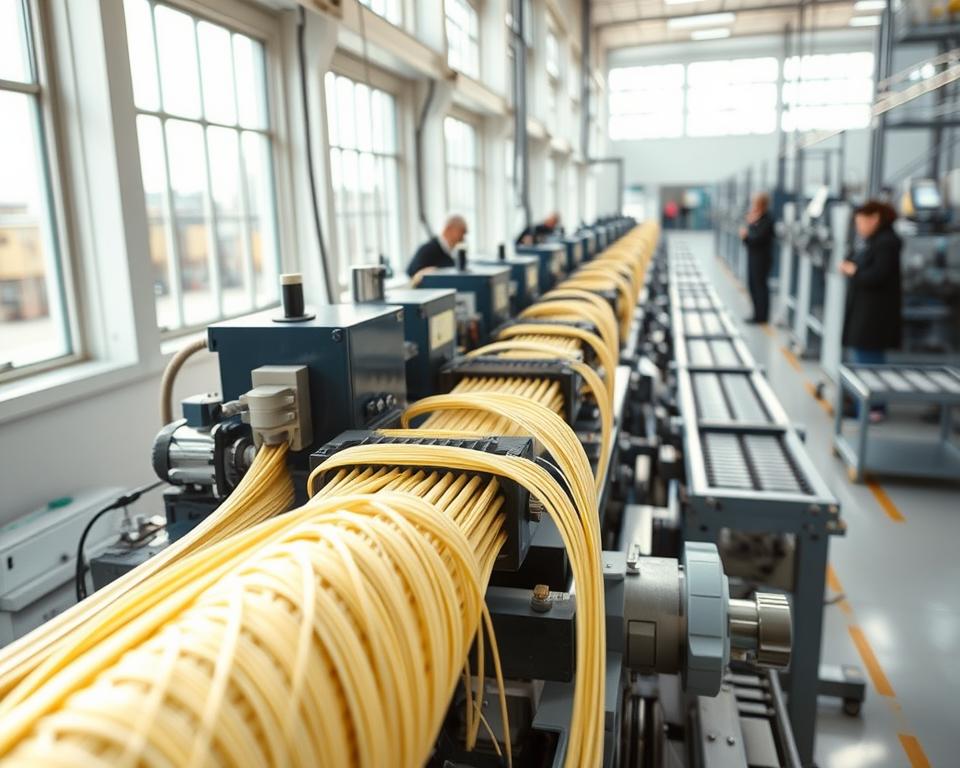K Silicate Facts: Crucial Uses & Benefits
Potassium silicate has been a pillar in diverse industries for over a century, yet its vast potential remains undervalued. This material is vital in sectors from construction to agriculture, underscoring its key roles and benefits. We will examine the intriguing realm of potassium silicate, also known as K silicate, to understand its importance in contemporary uses.
Delving into K silicate facts unveils its significant impact on upgrading materials and environmental sustainability. It’s vital for specialists in construction, environmental advocates, and anyone interested by new materials. This discussion intends to shed light on the significant role of K silicate in our world.
Key Points
- Potassium silicate is essential in the construction industry for its strength.
- This material is recognized for its eco-friendly features and safety characteristics.
- K silicate boosts moisture resistance and airflow in building materials.
- Its deployments extend beyond construction into areas like agriculture and industrial coatings.
- Knowledge with K silicate can boost consumer selections in sustainable products.
Insight to K Silicate
K silicate, alternatively called potassium silicate, is a compound produced by blending silica and potassium oxide. This combination renders it essential in diverse industries due to its varied properties. It is widely used as a adhesive in numerous materials.
Key characteristics of K silicate comprise its water resistance and durability. These features increase the life of construction materials but also secure their structural integrity. Its applications go beyond construction, penetrating agriculture and household products.
With a increasing emphasis on sustainability, potassium silicate is gaining prominence for its eco-friendly attributes. It permits industries to lower their environmental footprint while maintaining material strength and resilience. Thus, it’s a practical and sustainable choice.
| Attribute | Information |
|---|---|
| Chemical Makeup | Silica (SiO2) and Potassium Oxide (K2O) |
| Water Resistance | Very effective in moisture barrier deployments |
| Durability | Enhances longevity of construction materials |
| Environmental Impact | Promotes sustainable approaches |
What is Potassium Silicate?
Potassium silicate is an inorganic compound celebrated for its multiple applications and chemical properties. It is characterized as a combination of potassium oxide (K2O) and silica (SiO2). This blend forms a distinct binding agent vital across diverse industries.
The K silicate chemical composition contains about 30% potassium oxide and 70% silica. This ratio confers potassium silicate its distinct structure. It enables the material suitable for use in fertilizers, fireproofing materials, and paints.
Grasping the potassium silicate formula is crucial for comprehending its significance in industrial processes. The formula, K2SiO3, emphasizes its consistent and predictable chemical structure.
- Highly effective as a binder in construction materials.
- Employed as an adhesive in manufacturing processes.
- Facilitates improved water retention in agricultural applications.
Potassium silicate’s adaptability derives from its availability in both liquid and solid forms. This flexibility fulfills specific needs across diverse sectors. In agriculture, it is pivotal by enhancing nutrient availability and enhancing soil quality, thus fostering healthier plant growth.
| Property | Details |
|---|---|
| Potassium Oxide Content | 30% |
| Silica Content | 70% |
| Common Applications | Agriculture, Coatings, Fireproofing |
| Forms | Liquid, Solid |
History and Development of K Silicate
In 1768, the German poet and scientist J.W. Goethe uncovered potassium silicate. This finding laid the groundwork for comprehending its chemical structure and potential applications. The 19th century saw major developments, led by German scientist Georg Friedrich Keim. He developed silicate paints, opening up practical uses in the coating industry.
Throughout its history, potassium silicate has been employed in construction and agriculture. Initially, it was used to improve material durability and safeguard surfaces from environmental harm. Its flexibility increased over time, allowing it to move into diverse industries like ceramics and textiles.
The 20th century introduced further development, due to material science advancements. Researchers designed new formulations that enhanced bonding and weather resistance. These innovations extended its use across industries. Today, potassium silicate’s historical deployments emphasize its continued importance in industrial processes and sustainable construction.
| Era | Key Innovation | Applications |
|---|---|---|
| 1768 | Discovery by J.W. Goethe | Foundation for chemical comprehension |
| 19th Century | Development by Georg Friedrich Keim | Silicate paints and coatings |
| 20th Century | Progress in material science | Construction, agriculture, textiles |
Green Impact of Potassium Silicate
Potassium silicate is distinguished as a major component in the sustainable materials sector. Its minimal environmental footprint sets apart it from conventional organic coatings, which can release harmful substances. By employing potassium silicate, industries support sustainable practices and secure structures have greater longevity.
The sustainability of potassium silicate is reinforced by several critical factors:
- Non-toxic structure, rendering it safer for both applicators and end consumers.
- Biodegradable qualities that reduce long-term environmental harm.
- Improved breathability in building uses, which assists regulate indoor air quality.
Potassium silicate’s use in green building materials greatly reduces environmental pollution from standard coatings. Its part in sustainable architecture is vital, fulfilling the modern need for eco-friendly construction. Builders get substantial advantages in performance and environmental responsibility with this product.
| Feature | Potassium Silicate | Standard Organic Coatings |
|---|---|---|
| Toxicity | Non-toxic | Toxic by-products |
| Environmental Impact | Low | High |
| Biodegradability | Biodegradable | Non-biodegradable |
| Indoor Air Quality | Improves | Can degrade |
Inorganic Coatings Compared to Organic Coatings
The decision between inorganic and organic coatings is crucial in construction and manufacturing. Inorganic coatings are distinguished for their durability and environmental safety. They offer special merits that render them a preferred option in many uses.
Inorganic coatings, often derived from minerals like potassium silicate, shine in resisting water and operating well in harsh environments. Their antimicrobial characteristics improve hygiene and lengthen the life of surfaces. This renders them optimal for areas with heavy use.
Organic coatings, alternatively, are carbon-based and capable in many circumstances. However, they might have shorter lifespans as inorganic coatings and can need more maintenance. This might result in higher costs over time.
| Property | Inorganic Coatings | Organic Coatings |
|---|---|---|
| Durability | High resistance to wear and tear | Decent, varies based on formulation |
| Water Resistance | Excellent | Varies, some prone to damage |
| Antibacterial Properties | Present | Limited |
| Environmental Impact | Lower toxicity, safer for prolonged use | Higher volatile organic compounds (VOCs) |
| Longevity | Long-lasting, needs less often reapplication | Lower lifespan, higher maintenance costs |
Inorganic coatings are a preferred option for many uses, providing superior performance and environmental benefits. They demand less maintenance, causing them to be a practical option. The right coating can significantly impact a project’s durability and sustainability. It’s vital to understand these differences for better decision-making.
K Silicate Facts: Frequent Construction Applications
Potassium silicate is becoming more essential in the construction sector for its varied applications. Its distinct characteristics cause it to be optimal for various tasks, particularly in paints and coatings and as a part in building materials. This substance is valued for its potential to improve durability and sustainability in construction projects, delivering substantial benefits.
Uses in Paints and Coatings
Potassium silicate is vital in the manufacture of paints and coatings. It guarantees excellent adhesion and protects surfaces against environmental elements, causing it to be key for several industries:
- Mineral paints utilize potassium silicate for its durability and breathability.
- Commercial coatings include potassium silicate to enhance their performance against weathering.
- Interior paints use its binding properties for a seamless, durable finish.
Advantages in Building Materials
Integrating potassium silicate into building materials markedly improves structural integrity. This compound reinforces concrete and masonry, providing numerous advantages:
- It boosts resistance to cracking and wear.
- It improves water resistance, guarding against moisture damage.
- It improves thermal insulation, reducing energy costs.
The use of potassium silicate in construction underscores its vital importance in producing advanced materials and technologies. These encourage eco-friendly practices within the industry.
| Application | Benefits | Examples |
|---|---|---|
| Paints and Coatings | Strength, adhesion, weather resistance | Mineral paints, commercial roof coatings |
| Building Materials | Resilience, moisture resistance, thermal insulation | Concrete, masonry products |
Potassium Silicate Benefits
Potassium silicate boasts numerous merits, rendering it vital in diverse sectors. Its health advantages and eco-friendliness underscore its potential for broader use across industries.
Health and Safety Merits
Its non-toxic nature is a significant merit of potassium silicate. This ensures it’s safe for indoor settings, boosting air quality and avoiding health hazards. Moreover, it has low VOC emissions, a feature that matches current market trends. Consumers increasingly seek products that prioritize health and safety.
Green Credentials
Potassium silicate’s organic makeup renders it green. It needs less energy to manufacture than synthetic options, reducing its environmental impact. As sustainable building practices grow, potassium silicate’s popularity increases. It encourages efforts to lessen environmental harm, attracting eco-aware builders and consumers.
| Feature | Potassium Silicate | Synthetic Alternatives |
|---|---|---|
| Toxicity | Non-toxic | Potentially harmful |
| VOC Emissions | Low | High |
| Energy Efficiency in Production | Lower energy consumption | Higher energy consumption |
| Eco-friendliness | Yes | Varies |
Potassium Silicate Applications in Industry
Potassium silicate is crucial in diverse industrial sectors. It plays a key role in ceramics, agriculture, and manufacturing. Its impact is evident in boosting product quality and durability.
In ceramics, potassium silicate improves strength and thermal resistance. This renders ceramic products stronger across a diverse spectrum of applications.
In agriculture, K silicate enhances soil structure and nutrient availability. It aids in plant growth, allowing farmers raise crop yields and shield against pests.
The manufacturing industry relies greatly on potassium silicate for its binding properties. It’s employed in producing adhesives, sealants, and coatings. These products are known for their durability, crucial for industrial deployments.
Potassium silicate’s power to reinforce materials and enhance thermal stability makes it a top choice for industries pursuing quality and reliability. As innovation progresses, its deployments are likely to increase, creating new possibilities across sectors.
Fire-Resistant and Safety Characteristics
Potassium silicate demonstrates impressive fire resistance, able to endure temperatures up to 1300℃. Its high heat tolerance renders it invaluable in construction and manufacturing sectors, where flammability is a significant concern.
The flame retardant nature of potassium silicate improves safety in building materials and structures. It stops combustion, functioning as a protective shield against fire hazards. This is crucial in environments where fire safety compliance is required.
- Resists ignition, offering extra safety in case of a fire.
- Preserves integrity under extreme temperatures, preventing structural failure.
- Decreases the spread of flames, enabling more time for evacuation and response.
Incorporating potassium silicate into coatings and materials elevates their fire-resistant capabilities. By integrating these safety properties in building projects, it not only adheres to regulatory standards but also boosts overall safety for people and assets.
Water-Resistance and Breathability of K Silicate
Water resistance and breathability are vital features of potassium silicate in construction. Its distinct chemical makeup secures it keeps water out while allowing moisture to exit. This balance is key for the durability of building materials.
Employing potassium silicate as a coating safeguards surfaces from water damage. It lessens the risk of mold and mildew, which can harm indoor air quality and building structure. By being breathable, potassium silicate promotes optimal wall performance, enhancing indoor health.
Using potassium silicate in building materials provides major advantages in controlling humidity. It’s notably beneficial in regions vulnerable to high humidity or regular moisture. Here are the main benefits of potassium silicate for water resistance and breathability:
- Lessens moisture buildup and promotes air circulation
- Blocks water from seeping into surfaces
- Enhances the durability of coatings and finishes
- Supports energy efficiency in buildings
| Feature | Benefit |
|---|---|
| Waterproofing | Prevents water damage and deterioration of materials |
| Ventilation | Permits moisture to evaporate, reducing mold risk |
| Durability | Increases longevity of coatings and structures |
| Energy Efficiency | Lowers heating and cooling costs through better insulation |
Effective moisture management with potassium silicate properties enhances the performance and lifespan of construction materials. Implementing these benefits causes healthier environments and more robust structures.
Climate Durability Features of Potassium Silicate
Potassium silicate coatings exhibit excellent weather resistance, making them perfect for outdoor use. They can withstand rain, snow, and UV radiation, differently from traditional organic coatings. Their durability under tough weather conditions sets them apart.
One significant merit of potassium silicate is its excellent adhesion and moisture resistance. This guarantees the coating doesn’t degrade over time, unlike other materials exposed to moisture. The result is a protective layer that stops moisture and boosts the structure’s longevity.
Moreover, these coatings preserve their color vibrancy, even under intense sunlight. This feature causes them to be optimal for outdoor settings where aesthetic is crucial. Both homeowners and builders esteem their durability and design benefits.
| Feature | Potassium Silicate | Traditional Organic Coatings |
|---|---|---|
| Weather Resistance | Excellent; endures rain, snow, and UV exposure | Moderate; vulnerable to fading and degradation |
| Moisture Resistance | High; strong adhesion and reduced water penetration | Low to Moderate; vulnerable to water impact |
| Longevity | Long-lasting; maintains integrity across various climates | Shorter lifespan; demands frequent maintenance |
| Color Retention | High; prevents fading over time | Low; color can degrade quickly in sunlight |
Potassium silicate is becoming favored in modern construction for its sustainability and durability. This material not only boosts building performance but also boosts their visual appeal.
Key Potassium Silicate Formula and Composition
The potassium silicate formula is notable for its composition, mainly silicon dioxide (SiO2) and potassium oxide (K2O). These elements combine to establish a compound with special properties. These properties cause it to be optimal for numerous industrial applications.
This substance’s chemical structure permits it to function as a binder. It adds strength and durability to materials. Its attributes consist of resistance to water, high thermal stability, and superior adhesion. These features make potassium silicate crucial in construction, agriculture, and manufacturing sectors.
| Component | Function | Properties |
|---|---|---|
| Silicon Dioxide (SiO2) | Forms the backbone of the structure | Provides stability and durability |
| Potassium Oxide (K2O) | Improves bonding capabilities | Improves water resistance |
| Water | Fluid base | Aids in application |
Understanding the potassium silicate formula and its chemical makeup is vital to leveraging its full potential. Its distinct properties render it a go-to solution for experts globally. It is notable for its effectiveness across diverse industries.
Raising Consumer Awareness and Informed Choices
Raising consciousness about potassium silicate products is crucial to encouraging sustainable and safe building material choices. By comprehending the benefits of K silicate, consumers can make selections that benefit their projects and the environment.
Potassium silicate is versatile, notably in paints and coatings. It offers advantages like increased durability, fire resistance, and eco-friendliness. Yet, misconceptions about its application are widespread, highlighting the need for consumer education on its properties and benefits.
- Significance of understanding the components of potassium silicate products
- Identifying manufacturers committed to sustainable practices
- Assessing the performance characteristics of K silicate in real-world applications
By emphasizing these areas, consumers can take knowledgeable decisions. This approach doesn’t merely causes better choices but also encourages the use of eco-friendly alternatives in construction and renovation.
| Feature | Potassium Silicate Products | Standard Options |
|---|---|---|
| Environmental Impact | Low impact; natural mineral | Higher impact; synthetic chemicals |
| Durability | Long-lasting; moisture-resistant | Variable; may require more regular applications |
| Fireproofing | Highly fire-resistant | Often flammable |
| Application Ease | Straightforward to employ; versatile | Might require specific conditions for proper application |
Grasping potassium silicate products assists in making green purchasing decisions. When consumers opt for informed choices, they drive a market for safer, sustainable building materials.
In Summary
The summary on potassium silicate underscores its key role and broad deployments across industries. It’s a vital element for sustainable growth. Its part in enhancing construction material durability and providing environmental benefits is undeniable. K silicate is distinguished as a crucial asset in a market that’s constantly evolving.
Looking ahead, the future of K silicate looks bright with continued innovation. Increasing interest in potassium silicate among industries marks a shift towards sustainable product development. Its strong properties render it a top choice for manufacturers looking to boost their products and advance environmental goals.
In closing this discussion, it’s clear that potassium silicate will persist as essential for progressing sustainable practices. Its broad applications doesn’t merely improve product performance but also promote environmentally conscious solutions. This focus to K silicate use is pivotal in our pursuit for a sustainable future.



